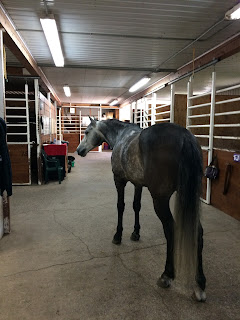Canter Protocol
I do lots of different kinds of rides, with lots of different kinds of riders. But cantering always has me stumped. I have an established checklist of rules, but not everybody shares my view on this. Here is the short version
- I do not ride on trail with anybody who is not comfortable cantering their horse (at least in an arena). I don't want their first canter experience to be the spook and bolt when their horse sees a deer. I will occasionally make an exception to this rule for very short and controlled trail rides within proximity to the barn.
- I do not race.
- The order we start in, must be maintained until the end. No passing. With some of my trail buddies we will canter side by side, and it is glorious!
- I do not gallop. I have made a few exceptions to this rule with individuals that I trust, and on a trail I know well. The gallop stretch never lasts very long.
- I do not canter up ravines or anywhere I do not have a long line of sight. Again, I sometimes make exceptions to this on easy sloped ravines with a clear view ahead.
- I never canter downhill. No exceptions. Soft tissue injuries taught me an important lesson here.
- I do not canter when the footing isn't perfect. No mud, no rocks, no stumps, no roots, no gravel.
- I do not canter without fair warning of transitions. If you take off cantering without having told me, I will never ride with you again. Even if my horse wasn't bothered by it.
All this means that my canter stretches are rarely very long (see footing and sight requirements above), nor very fast, and I usually will not canter with a new trail buddy until we have had several successful rides at a walk and trot and I have seen how much control they have.
I am blessed to have had horses that are comfortable walking when the other horses are galloping away, and I have never hesitated to just stop my horse until the yahoos get their yayas out. And then of course I never ride with them again.
Usually I am the trail leader. Often it is because I know the trails better than anyone, and also because I often have a "trail plan". Every once in a while, with buddies T, B or M, I will take a back seat and just follow along. But I have done hundreds of rides with these three and I know what I am signing up for when we go out. T goes fast and short, B goes long and slow, and M goes short and slow. And all three of them are amazing conversationalists.
So last week I took out my new buddy and boarder MJ and halfway into the trail she asked to canter (she was in second position). I wasnt quite "ready" but I knew the trail well, knew she wouldn't be able to pass me on the narrow wooded path, and MJ and her horse had been absolute rockstars up until then. So I said sure, and jumped to a canter. Q was hot and bothered by the dragon behind us (a stout part draft that really pumps the pistons hard at the canter) but he kept his pace reluctantly and give me more "up" than "forward". I guess it wasn't so bad because she asked again an hour later.
It all made me wonder. Maybe Im too strict. But I just feel like things can go wrong so quickly at the canter. And Im just not comfortable cantering in all situations.
Do you canter on the trail? Do you have rules? Are my rules too strict?






I learned a new word today. "Ghosting." It's unfortunate how often I've ghosted people who could have been horsey friends (neighbors). Ladies who, after assuring me we'd go out for a slow ride with my new mare (Mara), they took off cantering. WTH is wrong with people.
ReplyDeleteIt becomes a little harder to "ghost" people that are in the same barn ... but I have done it. ;-)
DeleteSometimes I watch the videos on the facebook group of ASTHE and am aghast at people racing and galloping past each other, with one person asking to stop and everybody else just laughing. I dont see it as a joke.
My trail rules are very similar to your trail rules, except I always offer to take turns letting another horse lead or follow, even when I know the trail best. Being able to follow or lead should be part of a good trail horses experience, and it helps to give the rider and horse courage. I like to change the leader many times during the ride, not just once.
ReplyDeleteHappy Trails,
Carol that is an excellent point! I also make a habit of switching the lead horse, going to the middle or the last position. My horse does well in all spots. And I think I shall do that next time my neighbour wants to canter. Hopefully she wont lose me in her dust. ;-)
DeleteI like your rules and it would make me feel very comfortable riding with you.
ReplyDeleteI like that you like my rules and that would make me feel very comfortable riding with you too! ;-)
Delete